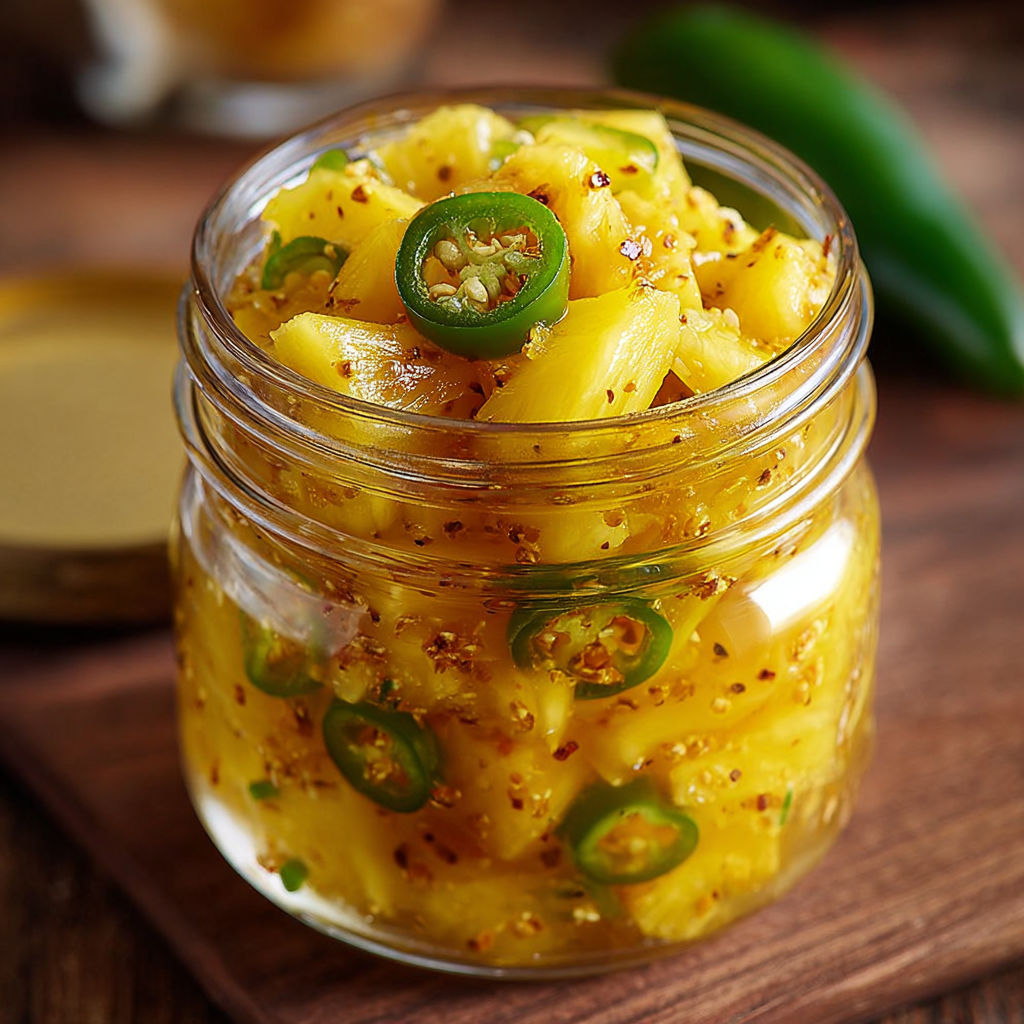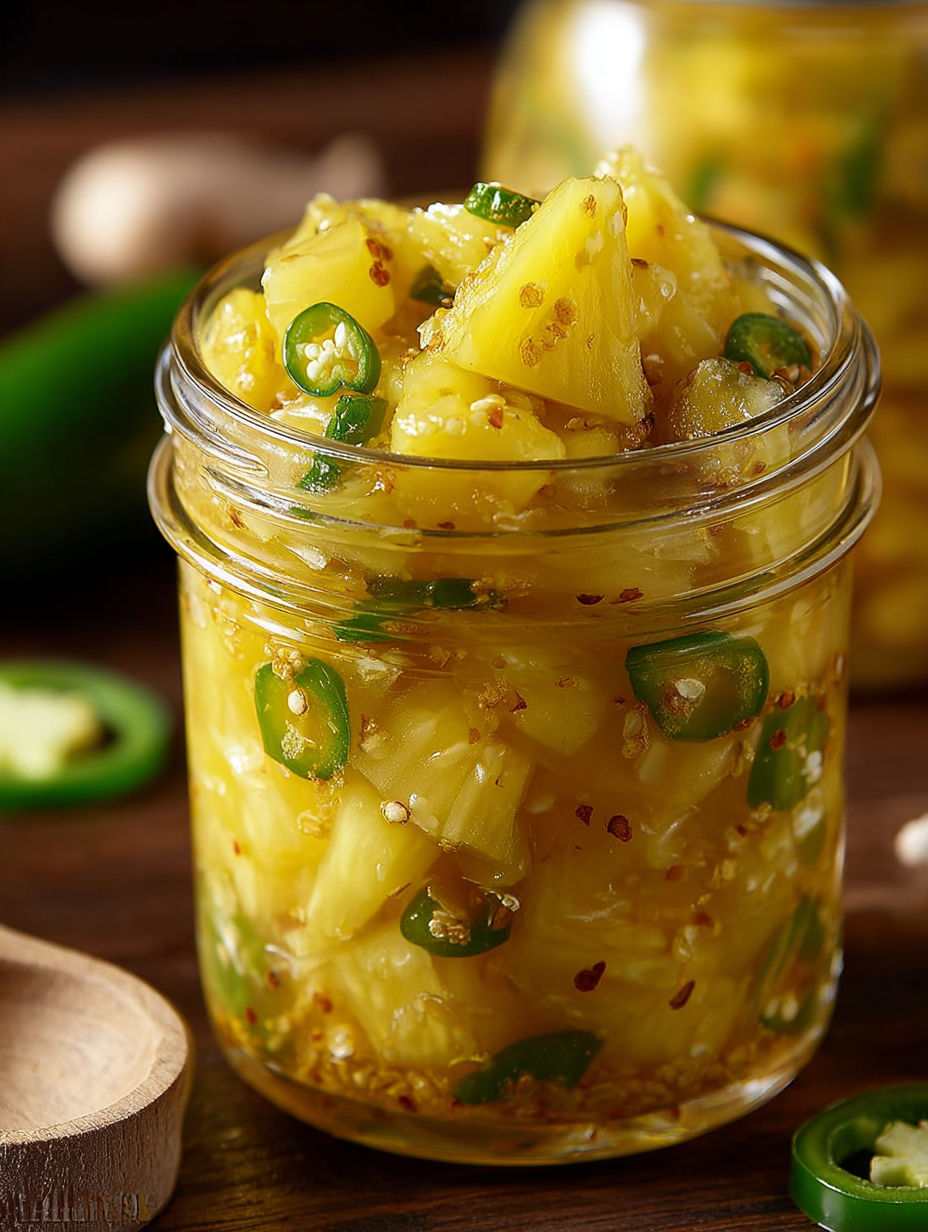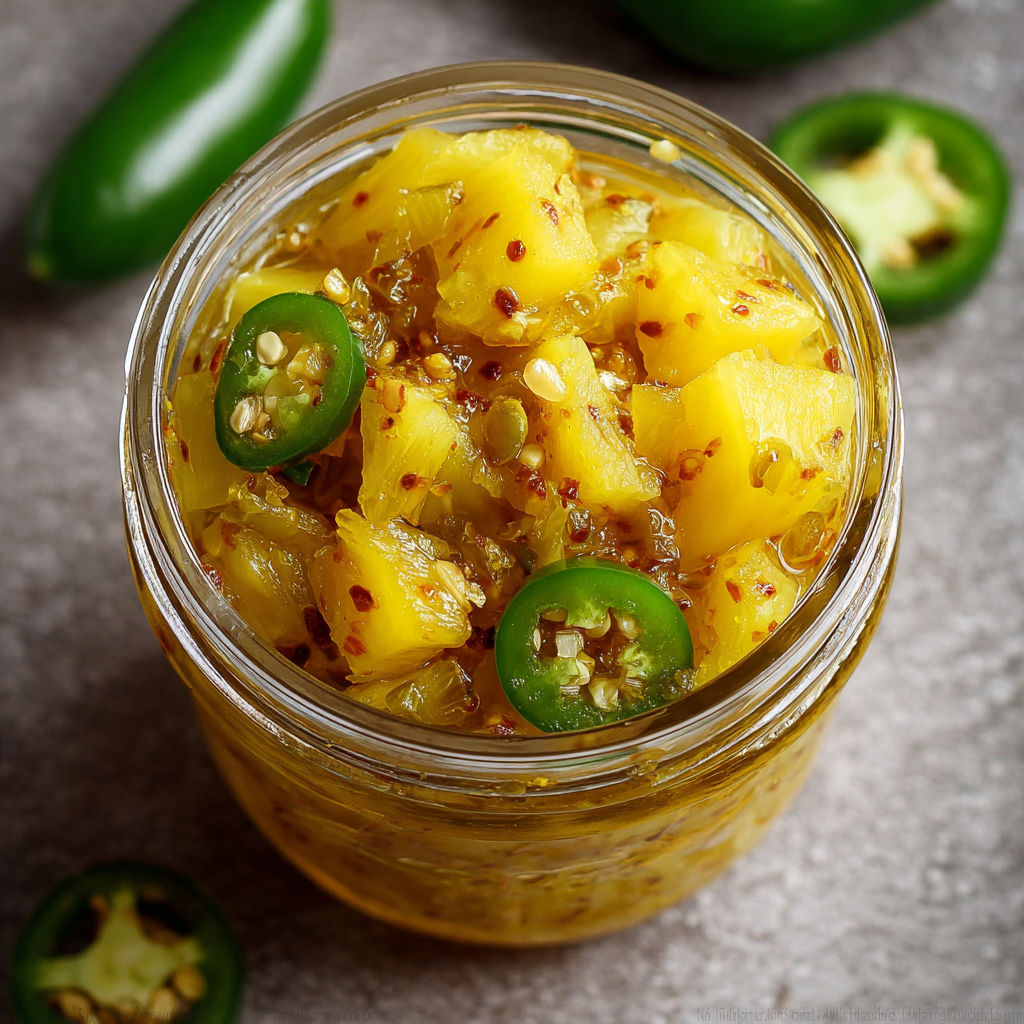 Pin
Pin
This sweet and spicy pineapple jalapeño relish has transformed my charcuterie boards and grilled meats from ordinary to extraordinary. The perfect balance of tropical sweetness with a kick of heat creates a versatile condiment that disappears quickly whenever I serve it at gatherings.
I first created this relish when looking for ways to use an abundance of jalapeños from my garden. What started as a kitchen experiment has become my signature condiment that friends request by name whenever they visit.
Ingredients
- Fresh pineapple provides natural sweetness and tropical flavor. Choose a ripe one with fragrant aroma at the base.
- Jalapeño peppers bring essential heat that balances the sweet pineapple. Adjust quantity for your preferred spice level.
- Apple cider vinegar creates perfect preservation while adding subtle tangy notes.
- Granulated sugar helps develop the syrupy consistency while balancing acidity.
- Lemon juice brightens flavors and adds natural preservation properties.
- Mustard seeds add tiny pops of texture and subtle spice notes.
- Turmeric powder contributes beautiful golden color and earthy undertones.
- Fresh ginger provides warming aromatic qualities that complement the pineapple.
- Garlic cloves add depth and complexity to the flavor profile.
How To Make Sweet Pineapple Jalapeño Relish
- Create the syrup base
- Combine vinegar, sugar, lemon juice and all seasonings in a large saucepan. Bring mixture to a gentle boil over medium heat, then reduce to a simmer until sugar completely dissolves. This creates a flavorful foundation that will infuse throughout the relish.
- Simmer with fruits
- Add diced pineapple and sliced jalapeños to your seasoned syrup base. Allow everything to simmer for about 20 minutes, stirring occasionally. Watch for the pineapple to soften slightly while maintaining some texture as the liquid reduces to a beautiful syrupy consistency.
- Prepare for canning
- While your relish simmers, sterilize canning jars and lids by submerging them in boiling water for at least 5 minutes. Having properly sterilized containers ensures your relish stays fresh and safe for months.
- Fill the jars
- Carefully ladle hot relish into sterilized jars, leaving about ¼ inch headspace at the top. Work efficiently while everything is still hot for proper sealing.
- Process and seal
- Wipe jar rims clean of any spilled relish, secure lids tightly, and process filled jars in a water bath canner for 10 minutes. This final step ensures proper sealing for extended shelf life.
- Cool and store
- Allow processed jars to cool completely on a towel lined counter for 24 hours. Check that lids have properly sealed by pressing the center. Store sealed jars in a cool, dark place for up to one year.
This relish holds a special place in my heart because it was the first canning recipe I mastered completely on my own. The vibrant colors remind me of summer even in the coldest winter months, and opening a jar instantly transports me back to those warm days of abundant harvest.
Customizing Heat Levels
The beauty of homemade relish lies in personalizing it to your taste. For a milder version, remove jalapeño seeds and membranes before slicing. If you crave more heat, substitute half the jalapeños with hotter varieties like serrano or habanero peppers. Remember that heat intensifies slightly during storage, so a jar that tastes perfect today might have more kick after a month in the pantry.

Perfect Pairings
This relish elevates countless dishes beyond basic condiment status. Spoon it over cream cheese with crackers for an instant appetizer that disappears quickly. Use it to brighten up grilled chicken or pork, where the sweet heat cuts through richer flavors beautifully. My personal favorite application is piling it onto fish tacos, where the tropical notes complement seafood perfectly. During summer gatherings, I always include a jar alongside burgers and hot dogs for guests who appreciate upgrading their grilled classics.
Troubleshooting Tips
Achieving perfect consistency takes practice. If your relish seems too thin after cooking, continue simmering until more liquid evaporates. For those who prefer a chunkier texture, reduce cooking time slightly to maintain pineapple firmness. If you notice separation during storage, simply stir before serving to redistribute ingredients. The natural pectin in pineapple helps thicken the relish, but ripeness varies, so adjust cooking time accordingly.

Recipe FAQs
- → How long does this pineapple jalapeño relish last?
When properly canned using the hot water bath method, this relish can last up to 12 months stored in a cool, dark place. Once opened, refrigerate and use within 2-3 weeks for best quality and flavor.
- → Can I adjust the heat level in this relish?
Absolutely! To decrease spiciness, remove the jalapeño seeds and membranes before slicing, or reduce the quantity. For extra heat, leave the seeds in or add a hotter pepper variety like serrano or habanero.
- → What dishes pair well with sweet pineapple jalapeño relish?
This versatile relish pairs beautifully with grilled meats, especially pork and chicken. It's excellent on fish tacos, as a topping for cream cheese with crackers, on burgers, or as a glaze for grilled shrimp. The sweet-spicy balance also complements charcuterie boards.
- → Can I use canned pineapple instead of fresh?
Yes, you can substitute canned pineapple in a pinch, but drain it well first and reduce the sugar slightly as canned pineapple typically contains added sweeteners. Fresh pineapple provides the best texture and flavor profile for this relish.
- → Is it necessary to process this relish in a water bath?
Yes, for shelf-stability and food safety, processing in a water bath is essential. If you prefer not to can the relish, you can store it in the refrigerator for up to 3 weeks, but it won't be shelf-stable.
- → Can I freeze this relish instead of canning it?
While canning is the traditional preservation method for this relish, you can freeze it in airtight containers, leaving headspace for expansion. Frozen relish will maintain good quality for about 2-3 months but may have a slightly softer texture when thawed.
